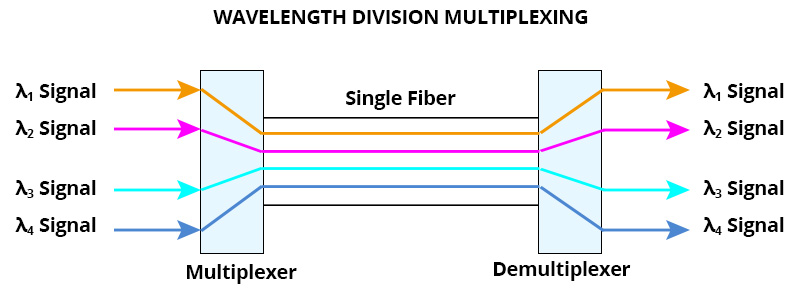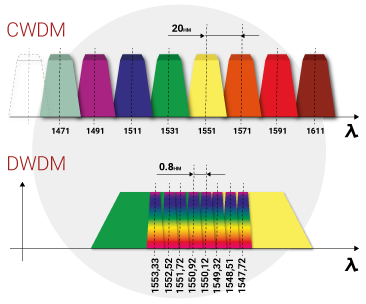What is the Difference Between DWDM vs CWDM Technology?
With the growth of Coarse Wavelength Division Multiplexing (CWDM) and Dense Wavelength Division Multiplexing (DWDM) technology, it made great progress in the development of optical transport networks. They both belong to WDM technology, and the principle of this technology is combining different wavelengths of optical signals on one optical fiber, through this way, the bandwidth of the optical fiber is increased. Then, do you know the difference between DWDM vs CWDM technology and how DWDM and CWDM technologies work?
Before introducing the difference between DWDM and CWDM, let's first understand what WDM, CWDM, and DWDM technologies are.
What is WDM Technology?
The Wavelength Division Multiplexing (WDM) can combine two or more different wavelengths of optical carrier signals on one strand of fiber by a multiplexer at the transmitting terminal, and coupled to the same fiber of the optical link to transmit optical data. At the receiving end, the optical carrier signals with different wavelengths are separated by a demultiplexer and then The optical receiver will further process the optical signals to recover them. This technology of transmitting two or more different wavelengths of optical signals at the same time is called Wavelength Division Multiplexing. The WDM technology can help the data centers to transmit large amounts of data between sites.

Figure1: WDM Working Principle
CWDM vs DWDM Wiki
As we all know, CWDM and DWDM are two different technologies developed based on WDM technology. They are applied in different fields because of different working principles. CWDM technology is more flexible, it can be used for most types of optical fiber networks. Engineers usually use it to build telecom access networks and it can also be used for point-to-point topology in the data centers. Not like the CWDM are typically deployed in enterprise networks, the DWDM is used in the metropolitan network in most cases. Besides, it can also be deployed on interconnecting data centers and build financial services networks, the DWDM technology is always deployed in a ring topology.
CWDM transceiver supports up to 18 wavelength channels to transmit through optical fiber simultaneously. The interval between every two different wavelengths of the channel is 20nm. While the DWDM transmits 50GHz optical signals it can support up to 96 wavelength channels and the interval between every different wavelength of the channel is 0.4nm, and the wavelength channels up to 48 and the interval between every different wavelength of the channel are 0.8nm while transmits 100GHz optical signals.

Figure 2: CWDM vs DWDM working principle
CWDM technology can support shorter distances of up to 70km, while the transmission distances are between 40 and 70 kilometers, it needs to limit the transmitting channel to 8 channels. The CWDM technology provides much convenience to the data center and gives a cost-effective solution to achieve long-haul transmission. The DWDM technology helps the metropolitan network to achieve a much longer transmission distance on DWDM devices. However, you need to use Dispersion Compensation or Amplifier to compensate for the fiber link loss and fiber dispersion.

Figure 3: QSFPTEK DWDM MUX
What is the Difference Between the DWDM and CWDM Technology?
Channel Spacing
The channel spacing is defined as the nominal difference in wavelength between two adjacent optical channels. Comparing these two different WDM technologies, the channel spacing of CWDM is wider than DWDM. As we mentioned above, The CWDM can transmit in 18 CWDM wavelengths and the adjacent optical channels spacing is 20nm, the spectrum range is 1271nm to 1611nm. The DWDM can carry 40, 80, 160 wavelengths with the channel spacing 0.8/0.4nm(100 GHz/50 GHz grid). The situation of 80 wavelengths and 0.8nm channel spacing is the most widely used. The DWDM wavelength range is C band(1525nm to 1565nm) and L band(1570nm to 1610nm).
Transmission Distance
Because the DWDM wavelength is highly integrated with optical fiber in the process of optical transmission, DWDM's transmission distance is farther than CWDM. Unlike the DWDM system, CWDM cannot transmit optical signals with unlimited distance. The maximum transmission distance of CWDM is about 80 km. DWDM can make the transmission distance farther according to the dispersion compensation or amplifier.
Modulation Laser
Another essential difference between CWDM and DWDM systems is that they have used different modulation lasers. CWDM is designed to use an uncooled laser, while DWDM uses a cooling laser. The difference between the two lasers results in better performance, higher security, and longer service life of DWDM MUX or transceiver, in contrast, CWDM MUX and transceiver have lower power consumption due to the use of electronic tuning uncooled laser.
Cost
The cooling laser not only brings better performance to DWDM but also takes more expensive costs to the DWDM system than the CWDM system. According to QSFPTEK, we know that the DWDM MUX is three to four times more expensive than the CWDM MUX. However, we need to note that due to the popularization of DWDM transceivers, DWDM transceivers are about one-fifth cheaper than CWDM transceivers.
Conclusion
CWDM is widely used in 10GbE or 16G fiber channels, while DWDM is widely used in the high-performance network of 100G capacity. We can know how to choose by comparing the advantages of both of them. The cost of the CWDM system is lower, the transmission speed of DWDM is faster, also, the bandwidth capacity is larger, and the transmission distance is longer. By comparing the advantages of both of them, and according to your requirements, I believe you already know which one is more suitable for your data center. QSFPTEK provides various CWDM and DWDM devices, including MUX and transceiver. If you are confused about choosing a DWDM or CWDM MUX and transceivers. Please contact customer service via [email protected].










